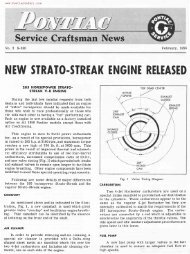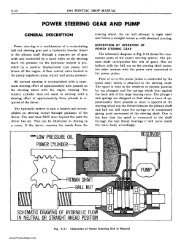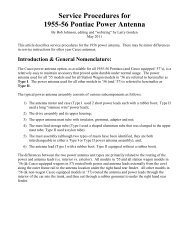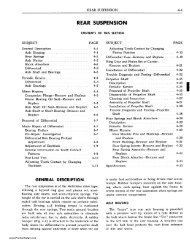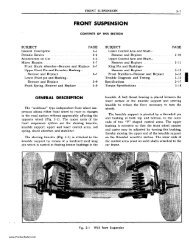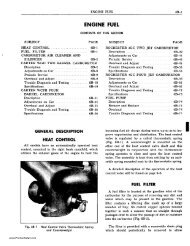Carter WCFB 4 - Pontiac Custom Safari 55 56 & 57
Carter WCFB 4 - Pontiac Custom Safari 55 56 & 57
Carter WCFB 4 - Pontiac Custom Safari 55 56 & 57
Create successful ePaper yourself
Turn your PDF publications into a flip-book with our unique Google optimized e-Paper software.
6B-22 19<strong>55</strong> PONTIAC SHOP MANUAL<br />
SECONDARY SIDE PRIMARY SIDE JET<br />
Fig. 68-41<br />
Low Speed Circuit<br />
Fig. 68-42<br />
High Speed Circuits<br />
LOW SPEED CIRCUIT (fIG. 6B-4JJ<br />
Fuel for idle and early part throttle operation is<br />
metered through the low speed circuit.<br />
Fuel enters the idle wells through the metering rod<br />
jets on the primary side of the carburetor. No idle<br />
system is used in the secondary side of the carburetor.<br />
The low speed jets measure the amount of fuel for<br />
idle and early part throttle operation. The air by-pass,<br />
economizer, and idle air bleed are carefully calibrated<br />
and serve to break up the liquid fuel and mix it with<br />
air as it moves thrpugh the passages to the idle ports<br />
and idle adjustment screw ports. Turning the idle<br />
adjustment screws toward their seats reduces the<br />
quantity of fuel mixture supplied by the idle circuit.<br />
The idle ports are slot shaped. As the throttle<br />
valves are opened, more of the idle ports are uncovered<br />
allowing a greater quantity of fuel and air<br />
mixture to enter the carburetor bores. The secondary<br />
throttle valves remain seated at idle.<br />
Air leakage at the gasketed surface surrounding<br />
the low speed mixture passages or between the flange<br />
and manifold may cause poor idle and low speed<br />
operation. Always use new gaskets.<br />
All by-passes, bleeds, economizers, idle ports, idle<br />
mixture adjustment screw ports, as well as the bores<br />
of the flange must be clean and free of carbon. Obstructions<br />
will cause poor low speed engine operation.<br />
Worn or damaged idle adjustment screws or low<br />
speed jets should be replaced.<br />
To combat engine stalling during warm-up on cool,<br />
humid days, caused by "carburetor icing", exhaust<br />
gas is circulated through a passage in the base of the<br />
carburetor flange. The heat transferred is sufficient<br />
to eliminate ice formation at the throttle valve edges<br />
and idle ports.<br />
HIGH SPEED CIRCUITS (fIG. 6B-421<br />
Fuel for part throttle and full throttle operation<br />
is supplied through the high speed circuits. Main discharge<br />
nozzles are permanently installed and must<br />
not be removed in service.<br />
PRIMARY SIDE<br />
The position of the metering rods in the metering<br />
rod jets controls the amount of fuel flowing in the<br />
high speed circuit of the primary side of the carburetor.<br />
The position of the metering rods is dual controlled;<br />
mechanically by movement of the throttle,<br />
and by manifold vacuum applied to the vacuum<br />
piston on the vacumeter link.<br />
MECHANICAL METERING ROD ACTION<br />
During part throttle operation, manifold vacuum<br />
pulls the vacumeter piston, link and metering rod assembly<br />
down holding the vacumeter link against the<br />
metering rod countershaft arm (Fig. 6B-43). Movement<br />
of the metering rods will then be controlled by<br />
the metering rod countershaft arm which is connected<br />
to the throttle shaft. This is true at all times that the<br />
vacuum under the piston is strong enough to overcome<br />
the tension of the vacumeter spring.<br />
VACUUM METERING ROD ACTION<br />
Under any operating condition (acceleration, hill<br />
climbing, etc.) when the tension of the vacumeter<br />
www.<strong>Pontiac</strong><strong>Safari</strong>.com



